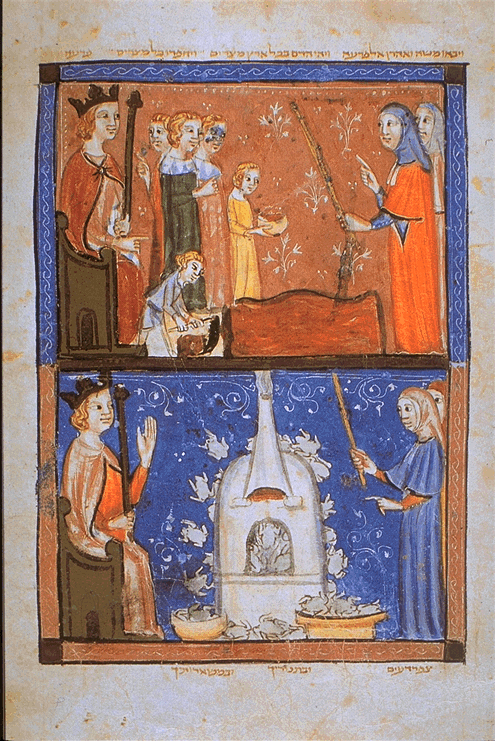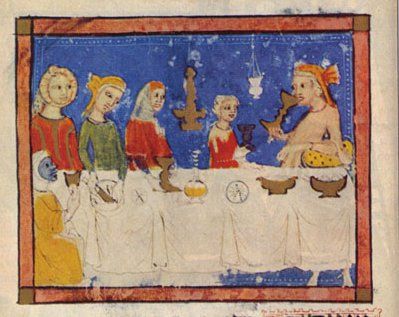I'll start this off with one of my favorite quotes from "Marginalia", a Billy Collins' poem: "Even Irish monks in their cold scriptoria/ jotted along the borders of the Gospels/brief asides about the pains of copying,/ a bird singing near their window,/ or the sunlight that illuminated their page-/anonymous men catching a ride into the future/on a vessel more lasting than themselves."
When I first read People of the Book by Geraldine Brooks, in the fall of 2010, I was only a few months out of college and had just started my first real jobs at a museum and a library. I was convinced at that time the museum route was the career path I wanted to follow. The library thing... was for extra money. (Not to say I didn't love it...after all, it was a library.) Today, two years later, that has changed and I like to think that People of the Book had a tiny bit to do with it.
I picked up People of the Book because I had loved Brooks's previous novels: Year of Wonders and March. It is difficult for writers to really portray the past effectively, but Brooks does. She gives her characters such life that it is easy to forget the boundaries of time and space; I can relate to each character, whether a Jewish scribe in 15th century Spain or a young mother in a 17th century English village. Yet historical truth is never compromised; instead, she manages to keep the integrity of the historical story, while still making each character approachable and human.You can see why I would love this.
People of the Book is my favorite of all Brooks's novels. It is the story of a religious text, an old, rare book that actually exists called the Sarajevo Haggadah. (A haggadah is a Jewish holy book used in the family home for the Passover Seder). This particular haggadah is richly illuminated, much like a medieval Christian Book of Hours, which sets it apart from other early Jewish texts.


It was likely created sometime in the late 15th century and has quite an amazing history. Somehow, it survived through many tragic world events,such as the Jewish expulsion from Spain, the Inquisition, the Holocaust, and the recent wars in Bosnia. In some ways, it is an amazing symbol of the Jewish people, and as People of the Book expresses, it is now also a symbol of Bosnia's multicultural pride. The People of the Book uses factual details about the book and its history to recreate and reimagine its story. The main protagonist is a book conservator, rebinding the haggadah after it has been saved from a bombed library in Bosnia. As she uncovers more details about the book- a butterfly's wing in the binding, salt stains on a page, a white hair tucked into a page- the narrative switches, working backward from the Holocaust to the haggadah's creation, giving the reader a glimpse of the book's past and the people behind it- creating it, using it, traveling with it, losing it, and saving it. Along the way, we discover where the wine stains came from and how to explain the salt crystals and the butterfly wing. Each chapter is a discovery, which adds up to an amazing story, one that satisfies my love for books and my fascination with people in the past.
Book-nerd that I am, I especially loved "watching" Hanna conserve the book; I fawned over the descriptions of gold-leaf and lapis lazuli, the book's quires and the binding and the fragments tucked into it. I remember thinking at the time how wonderful it would be to have a career like that, up close and personal with the remnants of people who lived and worked and worried and laughed long before my parents' or my grandparents' time, finding the clues to the past from books that acted as my only link to someone long forgotten.
Coincidentally enough, I had to clean several old books yesterday that had been donated to the Local History Room; a bit dirty, with mold spores on them, they needed a good once-over before being added to the collection. Since we don't exactly have a high-tech lab at the library, I just took them outside where the heat would help kill any extra spores (I waited for a low humidity day of course) and any mold spores were free to float away rather than into a vent, as it would if I handled them inside. There is nothing more exciting than cleaning old books. Bending over them with my brushes or handful of Absorene, I smile every time the colors of the binding or the page shines out from years of dirt and white mold residue. There was one book in particular I was excited about: a family Bible from an old family in town. The front page was beautifully inscribed; the dark ink strokes still looked as if they could be fresh and wet, despite the date of 1849. For a moment yesterday, I remembered People of the Book and I smiled. It is so fulfilling to feel like I can, in some small way, contribute to the life and story of something that, as Billy Collins said, is a vessel more lasting than myself. Long after me, that Bible will still bear testament to the people, named and unnamed, who used it, passed it down, and yes, even cleaned it. All of us "catching a ride into the future". While I still have so much to learn in this field, I am on my way. On my way and so much closer than I was when I first read about the Sarajevo Haggadah. Who knows how much closer I will be the next time I pick it up?
Beautifully expressed, Jillian...and I also loved this book.
ReplyDeleteThank you, Mrs. Zarnikow! Coming from you, that's a great compliment. I think I loved this book even more the second time around.
Delete